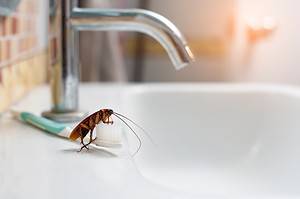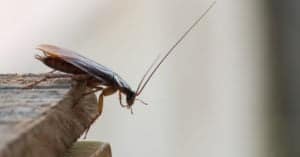People all over the world keep all manner of pets, ranging from fluffy dogs to six-legged pet hissing cockroaches. Cockroaches have been around for a very long time, over 300 million years; they’ve changed little in all those years. Today, there are over 4,500 species of cockroach around the globe. Only 1% of those thousands of species ever interact with humans. If not for the exotic pet trade, hissing cockroaches would never see a human, or know what it felt like to be held by one.
Here, we’ll take a closer look at the Madagascar hissing cockroach. We’ll dive into this creature’s defensive arsenal, and cover whether or not they pose a danger to humans. Then, we’ll talk about why, and how, they make that famous hissing sound. Finally, we’ll discuss whether hissing cockroaches make good pets, how to care for them, and how to handle them.
The Madagascar Hissing Cockroach
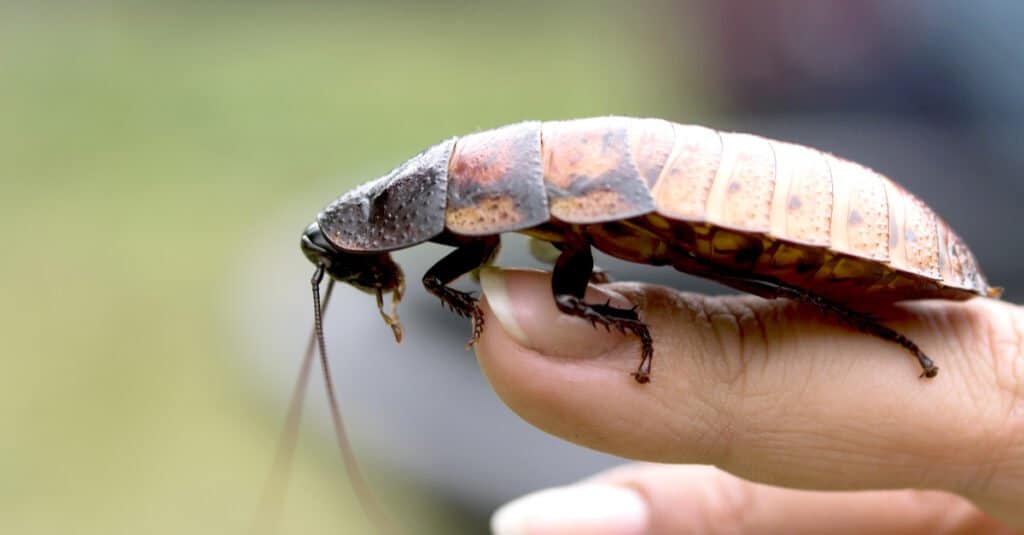
©kzww/Shutterstock.com
Gromphadorhina portentosa is a species of cockroach native to Madagascar. There are more than 20 varieties of hissing cockroach found on the island, though the Madagascar hissing roach is the most famous. They’re also known as hissing roaches, or simply, hissers. Hissing cockroaches are one of the largest roach species on the planet; they can grow up to three inches long and one inch wide. Like many large roaches, they’re completely wingless and have hard, waxy exoskeletons.
Hissing cockroaches are nocturnal, and prefer living in dead trees and fallen logs. They’re excellent climbers; if you look closely at their legs, you’ll see thick hairs that act as anchors for climbing. Females are ovoviviparous, meaning they keep their eggs inside their bodies until they hatch, then birth live young. Males are territorial and come equipped with large horns on their pronota—the shield-like structures that protect their heads.
Do Hissing Cockroaches Bite Humans?
With their size and armored plating, hissing cockroaches may look scary to some. But, rest assured—they don’t bite. Like most cockroaches, they’re scavengers and don’t hunt for their food. Their main source of defense is hiding from predators, not fighting. Even if they wanted to bite, they couldn’t; hissing cockroaches don’t have mouths designed for attack, only for eating.
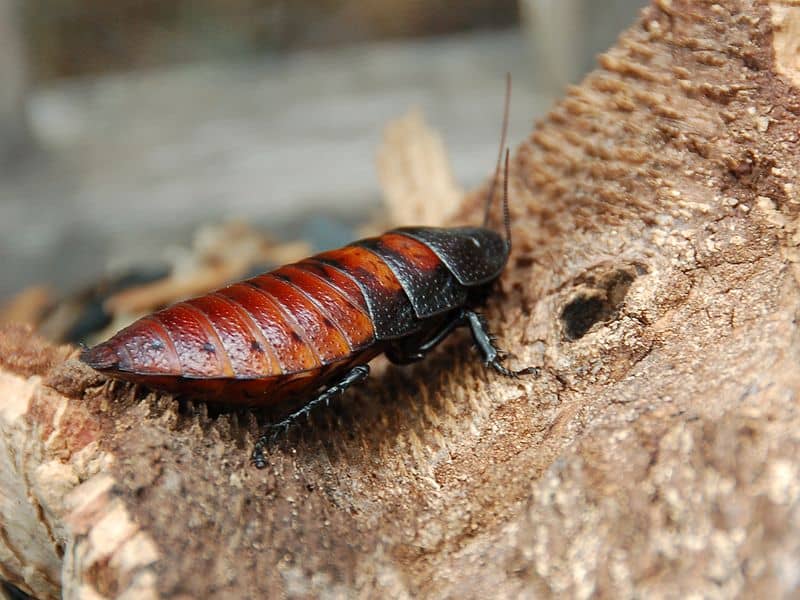
Pet hissing cockroaches are easy to take care of, entertaining, and friendly
©Almabes – Public Domain
Are Hissing Roaches Harmful?
Hissing cockroaches are not considered a pest species of cockroach, like the American or German cockroach. They don’t infest homes, and they tend to eat mainly plant matter. They’re not known to carry disease, and since they don’t cause infestations, they don’t trigger asthma in people. Hissing roaches do however have a waxy coating on their bodies; if you handle one, it’s important to wash your hands afterward to avoid ingesting the substance.
Why Do Cockroaches Hiss?
Hissing cockroaches don’t make noise by rubbing their body parts together, like crickets. Instead, they force air through openings called spiracles in their fourth body segment; the air creates the famous hissing sound.
Hissers may hiss for any of three reasons. Females and nymphs (baby cockroaches) only hiss when they’re startled, or they see something they think of as a threat. Male hissing cockroaches are very territorial, and also hiss to defend their territories, and to compete with other males for mating rights. Males also hiss at females to attract them.
Do Hissing Cockroaches Make Good Pets?
Though they’ve been slightly demonized on popular television, hissing cockroaches actually make good pets. They’re low maintenance, clean, entertaining, and, if raised kindly, friendly. Even better; they’re inexpensive to buy and don’t have complex (or expensive) habitat or feeding requirements.
Because of their gentle natures, entertaining hissing, and ease of care, hissing cockroaches have become popular pets for both children and adults. But, like many species of roach, they’re also bred as feeder insects for owners of exotic pets like reptiles and amphibians.
Caring For Your Pet Hissing Cockroach
The most important thing to remember when it comes to pet hissing roaches is that they need warmth, but not necessarily light. These large roaches are nocturnal, and need to have a good place to hide during the daytime. They’re also a warm-weather species, and should have a habitat between 75-85 degrees Fahrenheit. Many owners opt for small fish tanks with mesh lids for enclosures.
After habitat, the next most important aspects of caring for your pet roach are food and water. They need a fresh source of clean water; water should be changed every day. Additionally, they need soft substrates to live on, like coconut fiber or damp sphagnum moss. Hissing cockroach’s food requirements are pretty simple; leafy greens and high protein pellets, like dog or cat food. They also enjoy the occasional soft fruit.
How Long Do Pet Hissing Cockroaches Live?
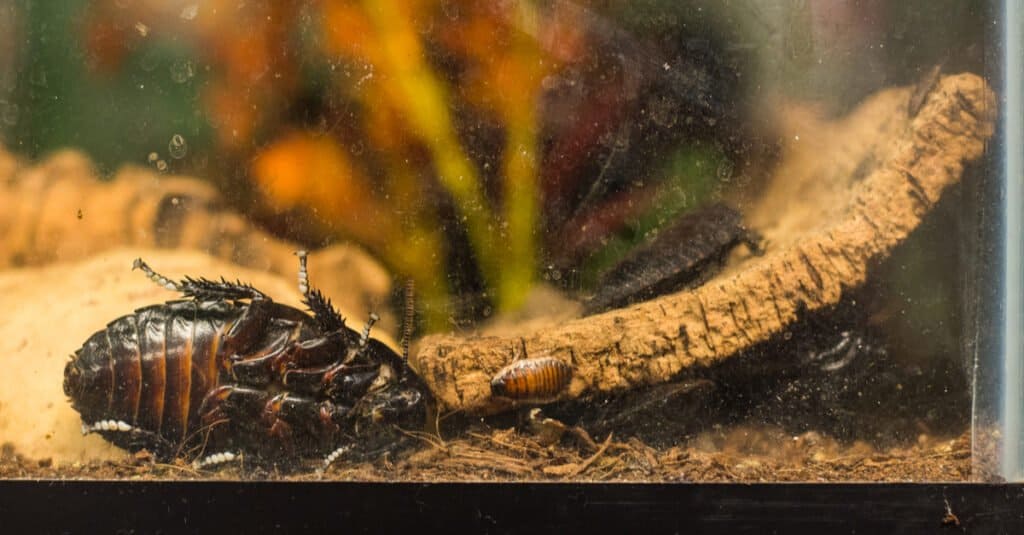
Pet hissing cockroaches eat leafy greens, some fruit, and high protein pellet food
©Ray Bernoff/Shutterstock.com
In the wild, hissing cockroaches have been known to live up to ten years. In captivity, they commonly live around three years. You can increase your pet hissing cockroach’s lifespan by ensuring that you keep its enclosure clean, and replace its substrate at least once a month. Further, keeping your roach’s water clean and removing any uneaten food will also limit sources of illness. Finally, proper handling to avoid injury is key to keeping your pet hissing cockroach alive and healthy for as long as possible.
How Do You Handle A Hissing Cockroach?
Pet hissing cockroaches don’t mind being picked up and handled, as long as they’ve been properly habituated. If you want to pick a hissing roach up, remember to never try lifting it by its legs or antennae. Don’t rip it away from the surface either; their legs have sticky spikes for traction, let them release from the ground on their own.
Hissing cockroaches should either be picked up from the forward thorax, or by tipping them out onto your hand. Once in your hand, don’t squeeze or drop them. A well-handled hissing roach will happily crawl on your hand or arm and provide endless entertainment and friendship.
The photo featured at the top of this post is © Keith Muzzioli/Shutterstock.com
FAQs (Frequently Asked Questions)
Are hissing cockroaches uneahlthy?
Cockroaches like German and American cockroaches that infest homes are extremely unhealthy. Hissing cockroaches aren’t a species that comes into homes and causes infestations and as such, don’t cause the same asthmatic response as invasive cockroach species. However, be aware that hissing cockroaches do have a waxy substance that should be washed off hands after handling them.
Thank you for reading! Have some feedback for us? Contact the AZ Animals editorial team.




